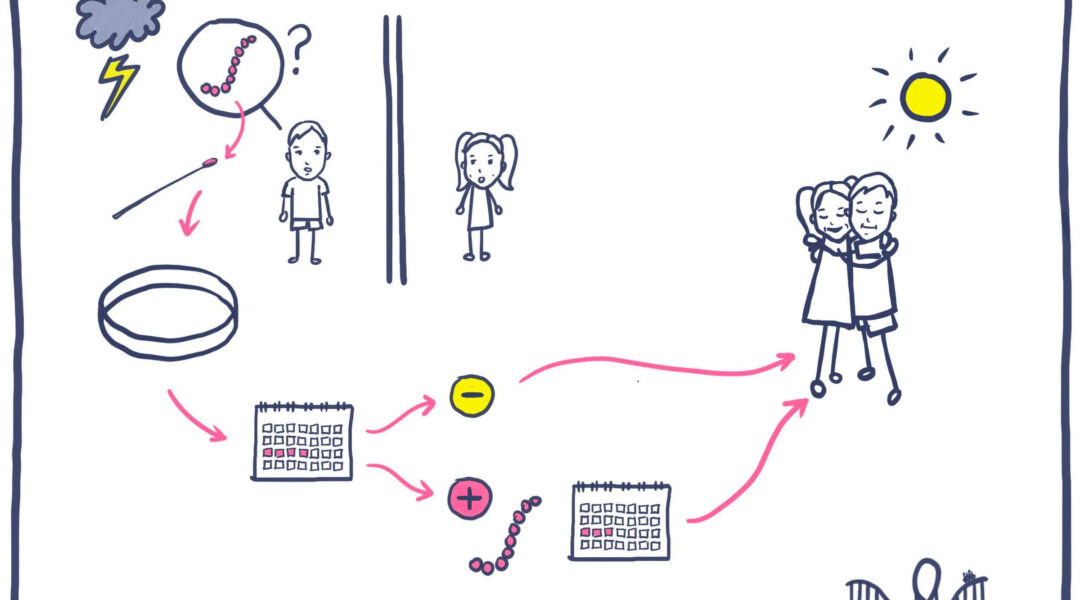Visual Communication for Explanations: How to Help Children Understand Medical Conditions
Last Friday, we were packed and ready to visit Germany when my wife Emilia spotted a faint sandpaper-like rash on our son Timo’s back. After 2.5 years of managing PANS/PANDAS, we knew this meant strep—and potential catastrophe for our daughter Luna who had just received IVIG treatment. We had to make the hardest decision: separate our twins for the first time in 8 years. What saved us from days of tears and confusion was the power of visual communication for explanations.
They were heartbroken until Emilia drew them a simple sketch showing:
- How to test if Timo has strep
- Why they needed to stay on different floors
- When they could hug again after treatment
“So I’m protecting Luna by staying upstairs?” Timo asked. “Exactly, buddy.” They got it immediately.
This is the power of visual communication for explanations—it transforms complex medical decisions into something children can understand and even embrace. At Life Science Animation, we say “Even your grandmother will understand your science,” but sometimes the most important audience is much younger.
Why Visual Communication for Explanations Works Better Than Words Alone
Our experience with our twins isn’t unique. Research shows that children process and retain information differently than adults. Their developing brains respond particularly well to visual information, making drawings, illustrations, and other visual aids essential tools for explaining medical conditions. When we use visual communication for explanations, children are more likely to:
- Understand what’s happening in their bodies
- Feel less anxious about medical procedures
- Cooperate better with treatments
- Express their own feelings about their condition
In our case, what could have been days of tears and confusion became a mission: Timo protecting his sister by staying upstairs, Luna keeping safe downstairs, and both understanding exactly why.
The Science Behind Visual Learning in Healthcare
Studies have demonstrated that visual aids activate different areas of the brain compared to verbal communication alone. This multi-sensory approach helps children:
- Create mental models of invisible processes (like how strep spreads between siblings)
- Reduce fear by making the unknown visible and understandable
- Improve retention of important health information
- Build confidence in managing their condition
Visual Communication for Explanations: Essential Tools and Techniques
1. Simple Hand-Drawn Sketches
Sometimes the most effective visual aid is a simple drawing created in the moment. Just as Emilia’s sketch helped our twins understand their separation, healthcare providers and parents can sketch:
- Basic body parts affected by the condition
- How medicine works in the body
- Why certain precautions are necessary
- The timeline of treatment and recovery
2. Anatomical Illustrations for Children
Child-friendly anatomical drawings that:
- Use bright colors and simple shapes
- Show only relevant body parts
- Include familiar objects for size comparison
- Feature characters or mascots to make learning fun
3. Story-Based Visual Narratives
Creating a visual story that:
- Features a character going through similar experiences
- Shows the journey from illness to recovery
- Includes positive outcomes and coping strategies
- Uses sequential images to show progression
4. Interactive Visual Tools
Engaging children through:
- Coloring books about their condition
- Puzzle-piece explanations of body systems
- Digital apps with animated explanations, like Portal Bio’s innovative cartoon approach to explaining complex science“
- 3D models they can touch and explore
Mastering Visual Communication for Explanations: A Step-by-Step Guide
Start with the Child’s Perspective
Before creating any visual aid, consider:
- The child’s age and developmental stage
- Their current understanding of their body
- Any fears or misconceptions they’ve expressed
- Their preferred learning style
For our twins, we knew they understood germs but needed to see why this separation was different from a regular cold.
Keep It Simple and Age-Appropriate
- Ages 3-5: Use very basic shapes and primary colors
- Ages 6-8: Add more detail but keep concepts concrete
- Ages 9-12: Include more accurate anatomy with clear labels
- Teenagers: Provide detailed, scientifically accurate visuals
Use Familiar Comparisons
Help children understand by comparing medical concepts to things they know:
- The heart as a pump
- White blood cells as body guards
- Medicine as tiny helpers
- In our case, strep as “tiny invaders” that Luna’s healing body couldn’t fight yet
Practical Examples of Medical Visual Communication for Explanations
Explaining Infections
Draw the body with tiny “germ” characters trying to get in, and show how:
- Hand washing creates a barrier
- Medicine helps the body’s defenders
- Rest gives the body energy to fight
- Why distance protects vulnerable family members
Explaining Chronic Conditions
Create a visual daily routine showing:
- When to take medicine (sun symbols for morning, moon for night)
- Which activities are safe and fun
- How to recognize warning signs
- Who to tell when feeling unwell
Explaining Medical Procedures
Illustrate the step-by-step process:
- What the child will see, hear, and feel
- Who will be there to help
- How long each step takes
- What happens after the procedure
Professional Guidelines for Visual Communication for Explanations
For Healthcare Professionals
- Have materials ready: Keep a basic set of visual aids for common conditions
- Personalize when possible: Add the child’s name or favorite colors
- Let children contribute: Invite them to draw their understanding
- Document effective visuals: Save successful explanations for future use
- Train staff: Ensure all team members can use visual communication effectively
For Parents
- Practice at home: Use visual aids to reinforce medical instructions
- Create a health journal: Let children draw how they feel each day
- Build a visual medicine schedule: Use pictures to show when and how to take medications
- Make it collaborative: Draw together to reduce anxiety
- Keep it positive: Focus on healing and health, not just illness
The Lasting Impact of Effective Visual Communication for Explanations
When we take the time to use visual communication for explanations with children, we’re doing more than just conveying information. We’re:
- Empowering children to be active participants in their healthcare
- Reducing medical anxiety and trauma
- Building trust between children and healthcare providers
- Creating positive associations with medical care
- Developing health literacy from an early age
Our twins now FaceTime each other from different floors, and Luna proudly tells everyone, “I kept Timo safe by staying downstairs!” What could have been traumatic became empowering—all through a simple drawing.
Making Visual Communication for Explanations Part of Standard Care
Healthcare facilities and families can integrate visual communication by:
- Creating libraries of condition-specific visual aids
- Training staff in basic drawing techniques
- Investing in child-friendly medical illustration resources
- Encouraging children to express their understanding through art
- Documenting which visual approaches work best for different conditions
Conclusion
Visual communication for explanations is more than just a helpful technique—it’s an essential bridge between complex medical information and a child’s understanding. As we learned firsthand, even the simplest sketch can transform a family crisis into a moment of understanding and cooperation.
Whether you’re a parent facing a midnight medical decision or a healthcare professional explaining a procedure, remember: the goal isn’t artistic perfection—it’s connection and comprehension. When we embrace visual communication for explanations as a standard part of pediatric care, we create a more compassionate, effective healthcare experience for our youngest patients.
At Life Science Animation, we’ve built our business on this principle, but it was in our own home, with our own children, that we truly understood its power. Visual explanation isn’t just our profession—it’s how we navigate our family’s medical journey.
If you want to find out more about our PANS/PANDAS journeys, subscribe to Emilia’s newsletter here.
Read more about

